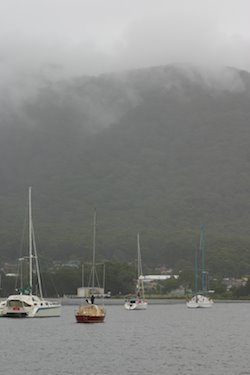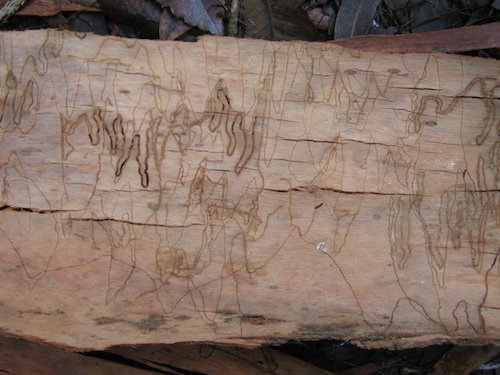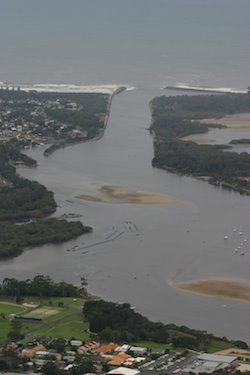
PINDIMARA (second yacht from the right) AT THE
FOOT OF NORTH BROTHER (looks like rain…)
Laurieton, where we remain at anchor sheltering from the storms, is dominated by a 500-metre mountain called North Brother, but known locally as Brother or just The Mountain. The locals hold it in some affection. It breaks up the wind, they say, and is an effective weather vane; if the top is in cloud, then it is going to rain. This is perfectly reasonable because North Brother is the first high point encountered by any incoming moisture-laden sea wind, which will have to shed at least some of its load in order to rise over the top. The slopes are therefore covered with dense rain forest, and Laurieton has a healthy rainfall. One morning we pumped nearly half a tank of fresh sweet rainwater out of our dinghy and into our depleted tanks; we’d have easily filled the 150-litre tank if the bottom half of the boat hadn’t been a bit silty.
I have long held that humans are attracted to edges. If we see a lake, we go down to the edge and skip stones. If we see a beach, we go down to the sea and say that we are invigorated (and build retirement homes). If we see a cliff, we go to the edge (perhaps not too close… depending on the rubber band effect of your own personal manifestation of vertigo… but we still go) and look at the view.
This isn’t too surprising. Life is all about edges. Walk through a natural forest, and you’ll see that most of the action happens around the perimeter, where young trees can compete for resources and animals can see danger coming, and yet still hide from it. Deeper inside the forest, the number of species drops and the forest is relatively quiet (except where a glade opens up when a tree falls; but that’s another, newly created edge). At the microscopic level, almost all of our biochemistry is mediated at the surface of the catalyst molecules that we call enzymes. We evolved from the moon-ministered tidal zone at the edge of the sea. Go diving, and it is immediately obvious that most of the life is congregated either in that tidal zone, or in a reef band further out just before the bottom slopes away into the deeps. Most of the rest is underwater desert.
To a greater or lesser extent, then, we all seek edges. Our urban and social life has removed our access to the more natural ones, and so we make up our own. How far can I swim? How high can I climb? How fast can I drive my car without going out of control? How close can I get to earning my salary without working too hard? How far can I push him before he cracks?
Having sat in the same stretch of river for a week, and having fixed and maintained just about everything that could be fixed and maintained, I was becoming increasingly obsessed with the idea of climbing to the top of The Mountain. On one particular day, with yet another set of storm warnings, gale warnings, and general mayhem out to sea, I shouldered a backpack and set off.
On the way through Laurieton, I stopped to ask about a footpath. It seemed that there was one, but nobody knew quite where it was as they usually drove to the top, so I just headed uphill until I found a trail and a NSW Parks sign said that it was a hard four-hour return trip. I know from experience that NSW Parks always inflate their figures by at least 100%, although I have never been able to decide whether this is to discourage the uncertain or to challenge the determined. Be that as it may, I knew that I’d be up and back in a couple of hours, so I checked my watch. The temperature was in the high twenties, the humidity must have been in the eighties, and the sun was just reaching its zenith; perfect timing for an Englishman to go exploring. Humming Noel Coward, I set off up the hill.
The trail had been hacked directly toward the summit. It was bloody steep, and shored up here and there with tree-trunk steps. At first I leapt gazelle-like from bole to bole, thinking “Hah! Four hours my foot!”, but before very long I slowed to a more reasonable pace. Sweat began to pour down my back, so that I first rolled up my shirt and then took it off and put the soaking rag into my pack. Venerable gums towered above, with a dripping understory of ferns, cycads and ‘black boy’ grasses. Birds shrieked in sudden startlement as I passed by; from the reaction of the animals and from the deep fallen brush along the trail, I could see that not many people passed this way. The trees were mainly scribbly gums, their bark decorated by the intricate maps of burrowing beetles.

A MAP TO SHOW THE WAY? SCRIBBLY GUM ART
Every now and then, an igneous rock outcrop thrust through the soil and towered over my head, making the way slippery underfoot with loose eroded pebbles. I began to pant in the heat, and to wonder if I was going to make it, the legacy of too many months doing overtime in an office chair followed by days of sitting around doing schoolwork on the boat. I struggled on. I was glad to note that my heart wasn’t pounding and that my breathing was relatively normal, but I was sweating buckets and my legs had begun to go rubbery when I emerged blinking into a clearing that marked the top of the trail and the beginning of what was described as ‘the easy traverse’.
With sudden renewed energy I set off along the new path, which ran in a gladdeningly horizontal fashion before – horror of horrors – actually running downhill and robbing me of hard-gained altitude. Round the next corner came the punchline of the joke; the trail reverted back to the familiar vertical climb.
After an hour’s sweaty effort, I emerged suddenly onto a neatly grassed forty-five degree lawn which turned out to be a launch pad for hang gliders. Spinning around, I was presented with a view that made the whole thing worthwhile. Not just one edge, but three, if you included the distant beach and the even more distant horizon. Far below, I could just make out the shape of Pindimara bobbing on her mooring.

PINDIMARA (topmost rightmost yacht) AT THE
BOTTOM OF NORTH BROTHER, WITH LAURIETON
IN THE FOREGROUND AND THE CAMDEN HAVEN
BAR IN THE BACKGROUND
A half hour for lunch while I drank in the views. Edges are good for the soul.
Then back to the trail, initially running with sheer exuberance until my legs turned to jelly, and then a more cautious descent to sea level, which was in its own way just as much hard work as the journey up.
Back at the marina I took a shower and then stood on the dock looking at the yacht. Usually I would call Bronwyn on my mobile so that she could row over and get me, but today the Vodafone signal was unaccountably absent. As I waited to see if she would happen to appear on deck, I saw a small movement out of the corner of my eye, and crouched down to have a look. A small leech was inch-worming its way across the wooden planking, mouth parts eager and stretching at the top of each loop. I stepped back to let it go by, wondering what it was doing in such a bare and unfriendly environment. It came to the edge of a plank and then snuck down into a crack, whereupon I became aware of a lot of crimson splashing; there was fresh blood pouring down my lower leg. I couldn’t feel any pain, but when I wiped it away I could see a couple of fresh bite marks, so presumably I had been carrying more than just memories home from the rain forest.
Ah well. Salt water would fix it. I stashed my bags on the dock, and swam out to the boat.